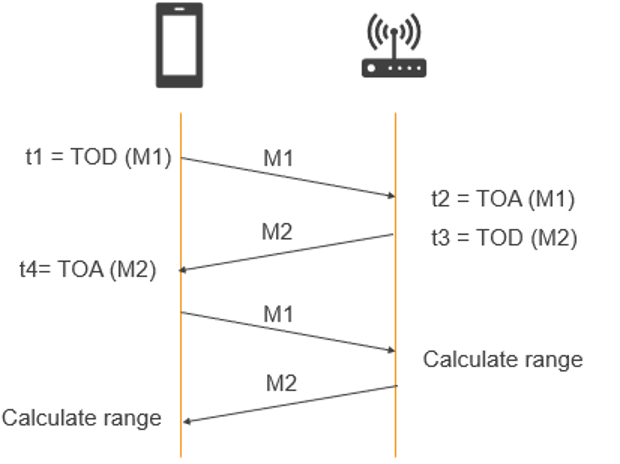How Bluetooth 5.1, Ultra-Wideband and Wi-Fi 802.11az Compare to Provide Accurate Location
LitePoint’s Eve Danel is the author of this blog. In this post, you’ll learn about updates to the Bluetooth, Ultra-Wideband and Wi-Fi specifications that improve location capabilities.

Recent standards updates to Bluetooth, Ultra-Wideband and Wi-Fi have introduced new and more accurate location capabilities that allow wireless device designers to use these technologies to support new indoor location applications. In this blog post we will review these methods and see how they compare to provide improved capabilities.
These location capabilities can be used to find people or objects with high accuracy where GPS and other satellite technologies – which are primarily for outdoor applications – lack precision or are blocked by buildings or other obstructions. While other indoor positioning systems can detect the location of an object, their accuracy can be on the order of several meters – which means that they cannot be used in many applications where more precision is required.
Both Bluetooth and Wi-Fi have already been used in many deployments for indoor location. Previous versions of these technologies had location capabilities that were based primarily on receive signal strength indicator (RSSI). This method can determine the distance between the transmitter and the receiving point by measuring the received signal strength, and then perform positioning calculations based on the corresponding signal attenuation. The accuracy of the RSSI method is limited by several factors, primarily if there are obstacles between the transmitter and the receiver causing attenuation, the accuracy of measurements will be reduced. The signal strength measurements can also be degraded if they are not calibrated, making the location calculation inaccurate by a few dBs.
The RSSI method is also inherently not very secure. It can be subjected to a “man-in-the-middle” (MITM) attack. This happens when attackers amplify the transmission to make the transmitter appear closer than it really is.
The next generation of positioning technology aims to unlock an even higher level of security as well as accuracy down to the tens of centimeters. Micro-location opens up a new generation of use cases allowing users to interact very precisely with their environment and the objects around them.
Bluetooth Low Energy 5.1
The recent addition of the Bluetooth 5.1 standard adds several direction-finding enhancements, providing angle information to the incoming signal. The standard specifies two methods: angle of arrival (AOA) and angle of departure (AOD).
For direction finding, the Bluetooth 5.1 devices transmit specially formatted packets and Bluetooth 5.1 receivers use an antenna array with at least 2 antennas to compute the angle of incidence based on the phase difference between the antennas, the signal’s wavelength and the distance between the antennas.
Combining RSSI information with either AOA or AOD provides the ability to determine the device location with better accuracy.
Ultra-Wideband (UWB)
Ultra-Wideband, or UWB, based on the IEEE 802.15.4z-2020 HRP ERDEV (Enhanced Ranging Devices) amendment provides high accuracy and secure positioning.
UWB doesn’t use signal strength to evaluate distance. Instead, it uses time of flight (ToF).
ToF measures the propagation time that it takes for the signal to go from the transmitter to the receiver. Signals travel at the speed of light, regardless of environment. Distance estimation based on timing is more robust and is not affected as much by the environment as the RSSI methods that were described earlier.
UWB is more robust to the man-in-the-middle attack described earlier because a signal cannot be intercepted and retransmitted without adding latency, in addition frames containing an STS (Scramble Timestamp Sequence) with AES-128 encryption provide an added layer of security.
Wi-Fi IEEE 802.11az
The IEEE 802.11az Next Generation Positioning (NGP) standard is nearing completion and it is building upon the fine timing measurement (FTM) feature that was part of the IEEE 802.11mc standard release. Unlike the RSSI method using signal strength to evaluate distance, FTM uses round trip time information to estimate distance between Wi-Fi enabled stations and access points.
The 802.11az standard is designed to improve upon the FTM legacy with NGP which uses several enhancements that are aligned with the 802.11ax/ Wi-Fi 6 standard. The Wi-Fi Alliance is also working on the next generation Wi-Fi location R2 program based on NGP.

Figure 3: Wi-Fi Timing Measurement Round Trip Time
FTM uses Time-of-Flight to measure distance. The mechanism is very similar to UWB’s ToF described earlier. Wi-Fi client stations and access points exchange a series of messages with Time of Departure and Time of Arrival timestamps that allow to derive round-trip time. Round trip time mechanism doesn’t require the clocks on the devices to be synchronized.
802.11az is designed to improve upon the legacy FTM by utilizing the latest features in the 802.11ax standard.
- For improved accuracy 802.11az is making use of wider channel bandwidth, up to 160 MHz for Wi-Fi 6 but this could be extended to 320 MHz for the 802.11be (Wi-Fi 7 generation) since wider bandwidth provides higher resolution. For better resilience to multi-path effects MIMO signal properties are being utilized.
- For improved protocol efficiency 802.11az reuses the 802.11ax PHY Null Data Packet (NDP) frames that are already defined for beamforming sounding. The timestamps are based on the exchange of HE ranging null data packet (NDP) frames or HE trigger-based (TB) ranging NDP.
- The Multi-User capabilities of Wi-Fi 6 are also advantageous to 802.11az, when using Trigger based ranging with Uplink and Downlink OFDMA, the AP can effectively get ranging information from multiple stations in a single transmit opportunity. This feature significantly reduces the overhead needed for exchanging ranging information and improves scalability to more stations.
- 802.11az introduces PHY and MAC layer Security enhancements to prevent spoofing or eavesdropping on ranging messages.
Testing Concerns
What’s true of all these wireless location technologies is that careful design validation testing is required to ensure the best performance. LitePoint’s wireless test product portfolio has the right solution to enable these technologies.
The IQgig-UWB™ tester is a fully integrated, one-box test solution for physical-layer testing of UWB-enabled devices. It supports all the required transmitter receiver testing, but it also has specific mechanism to test UWB ranging with a precision trigger and response mechanism that allows calibration and verification of ToF and AoA measurements.
To listen to my entire webinar on this topic, please go to the LitePoint webinar page.
